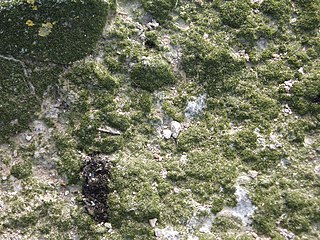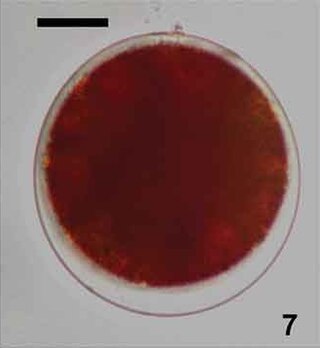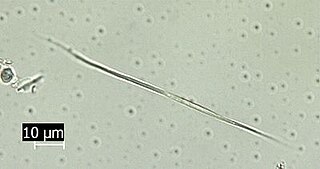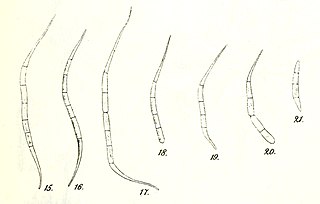
Prasiola is a genus of macroscopic green algae, found in a variety of habitats ranging from terrestrial, freshwater, to marine. The genus has a cosmopolitan distribution, ranging from the Arctic to the Antarctic.

Microthamniaceae is a family of green algae in the class Trebouxiophyceae. It is the only family in the order Microthamniales.

Prasiolales is an order of green algae in the class Trebouxiophyceae. Members of this order are ecologically widespread and are found in freshwater, marine, and terrestrial habitats from the Arctic to the Antarctic.

Botryococcaceae is a family of green algae in the class Trebouxiophyceae.

Prasiolaceae is a family of green algae in the order Prasiolales. Members of this family are found in freshwater, terrestrial, and marine habitats.

Selenastraceae is a family of green algae in the order Sphaeropleales. Members of this family are common components of the phytoplankton in freshwater habitats worldwide. A few species have been found in brackish and marine habitats, such as in the Baltic Sea.

Chlainomonas is a genus of algae in the family Chlamydomonadaceae. They are found in freshwater habitats or on snow, where they are one of the main algae responsible for causing watermelon snow.

Chloromonas is a genus of green algae in the family Chlamydomonadaceae. It is closely related to the model green algae, Chlamydomonas, and traditionally has been distinguished mainly through the absence of a pyrenoid.
Desmococcus is a genus of green algae in the family Stichococcaceae. It is a subaerial genus of algae with a cosmopolitan distribution.
Dicloster is a genus of green algae in the family Chlorellaceae, containing the sole species Dicloster acuatus. It is found in freshwater habitats as plankton, and is distributed around the world.
Dictyochloris is a genus of green algae in the class Chlorophyceae. It is the sole genus of the family Dictyochloridaceae. It is commonly found in terrestrial and subaerial habitats.

Didymogenes is a genus of microscopic green algae in the class Trebouxiophyceae. It is a planktonic species found in freshwater habitats worldwide. Formerly placed in the family Scenedesmaceae, molecular studies have placed it in the family Chlorellaceae.

Gloeotila is a genus of green algae in the class Trebouxiophyceae. It is typically found in freshwater habitats, either attached to surfaces or planktonic, or found in soil.

Koliella is a genus of green algae in the order Prasiolales. Members of this genus are found in freshwater plankton, but some are also found on snow and ice.

Lagerheimia is a genus of green algae in the family Oocystaceae. It is commonly found in freshwater habitats all over the world, although some species are rare and have only been recorded from Europe or the United States.

Microthamnion is a genus of green algae in the family Microthamniaceae. It is found in freshwater habitats around the world, preferably with low levels of pollution; it is typically attached to solid substrates.

Rosenvingiella is a genus of green algae in the family Prasiolaceae. Members of this genus are found in marine or terrestrial habitats.

Stichococcus is a genus of green algae in the family Stichococcaceae. It is a very common algal genus found in a variety of habitats, such as tree trunks, soil, snow, freshwater and marine habitats. One species, Stichococcus bacillaris is economically important as it produces fatty acids useful for biofuels.

Raphidonema is a genus of filamentous green alga comprising five species. It is a member of the Trebouxiophyceae.

Koliellaceae is a family of green algae in the order Prasiolales.














